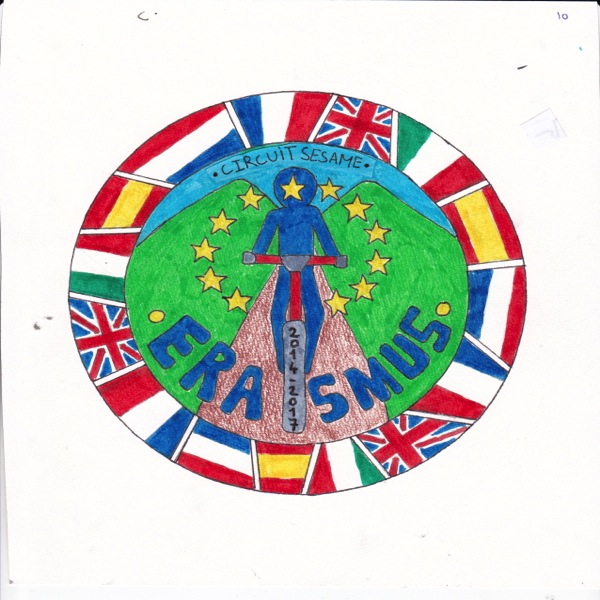

TEACHING
NAVIGATION
A Classroom guide
TEACHING NAVIGATION
Introduction
These is section is the starting point to teach navigation. It aims to introduce the basic concepts. It will endeavour to give advice to teachers wishing to introduce students to the skills necessary to navigate in the countryside or to follow a cycle map.
Experienced cyclists and hill walkers in general are not excited by a book cover with pictures of lycra clad models running or cycling through the forest holding a map and compass.
The key point is how do experienced walkers become skilled in navigation and how do we as teachers share our knowledge with our students?
During the project Circuit Sesame, we found ourselves introducing basic navigation skills. There are many texts and resources on leisure navigation available but there is little information for teachers on how to teach navigation skills.
Navigation using geocaching, sat nav or google maps will be included in a separate section. In this section we are limiting ourselves to teaching navigation from a map for walking.
The Teaching Process
The first challenge that we as teachers encounter is the map scale. The 1:50,000 scale map is widely available and convenient but it is difficult to teach navigation with this format because it involves travelling to great a distance. The scale 1:50,000 is difficult for novices to relate to, it does not represent the detail of what they see on the ground and it keeps teachers and students in a geography classroom and limiting their opportunities to apply their knowledge.
The lack of detail and comparative distance between features with a 1:50,000 scale does not give immediate results,
So start teaching your lessons with a scale of around 1:10,000. This makes it easier for you to set targets, and for students to see results, gain confidence and most importantly have fun.
In teaching navigation you should always bear in mind that your duty is not only to teach your knowledge but to build their confidence at every stage.
Building Navigational Confidence.
- It sounds obvious but begin to build confidence by providing learning opportunities in a safe and non-threatening environment. This environment should start as simply as navigating around a table top or a board game. Move on to navigating around the classroom, before extending the students expertise in a gym or hall, school grounds before finally moving to the outdoors. Even when finally moving outdoors, gradually extend the range of exploration and navigation from enclosed parks to more open countryside. Once the students are comfortable with navigation in a benign conditions you could extend it further to night time, bad weather navigation, but it is essential that the environment you work on is appropriate for the age / level of the group. If the environment appears threatening the learners are not going to be
- focused on learning the navigation skills.
- Use map scales that have all the detail on to start with e.g. 1:10,000 before moving on to less detailed maps. Once students have acquired the basic the skills then you can progress to increasingly remote environments with larger map scales to match.
- At each stage, build learner’s confidence by starting within a group context, allow them to develop confidence by initially arriving at decisions democratically and collectively before progressing to working in pairs and finally solo.
Summary
Beginning with safe and confined environments under close supervision in the early stages gives instant support, the opportunities for more practice and thus the opportunity to address any conceptual errors. It allows the use of variety of coaching styles and involve the group in the coaching and development process. There is less chance of a major loss of confidence
Lastly it is rewarding for the teacher to actually seeing the group learn, develop in confidence and hopefully have fun.
A Stepped Approach
Orienteers have long used a stepped approach to learning navigation, this involves each step being completed with feedback confirming the level to students have grasped the concepts and we as teachers do not extend teaching the necessary skill set until we are satisfied that our learners have demonstrated expertise in the existing skills prior to moving on.
Without the fundamentals, all else is a struggle. This introduction should demonstrate the ideas for coaching each step and how to assess the student’s understanding of the techniques covered.
There is a extensive library of games and exercises using simple small scale maps and these are showcased in the opening sections.
Following these elementary ideas, the emphasis progresses on to developing experience and confidence using the 1:50,000 map in the hills. Yet even these more challenging skills can be broken down and coached with some short fun exercises.
Example
When teaching how to take a bearing cross country, break the task down into a sequence of all the sub tasks involved and teach them individually before putting them together. With each step think of an exercise or teaching method that can largely be done in a park or school grounds
1. Taking a bearing from the map
2. Measuring a distance & converting that to pacing / timing
3. Follow a bearing (& reading the map– thumbing their route as they go)
4. Identifying and using catching features if learners overshoot.
5. If you overshoot you then also need to make sure that people have the
relevant relocation skills to either retrace their steps or relocate and use a new attack point.
Each of these can be taught as individual elements in progressive environments
and as group, pairs or solo activities.